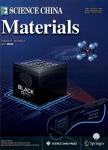揭示相共存体系PbTiO_(3)-BiScO_(3)中内在和外在压电贡献
Revealing intrinsic and extrinsic piezoelectric contributions in phase coexistence system of PbTiO_(3)-BiScO_(3)作者机构:Beijing Advanced Innovation Center for Materials Genome EngineeringUniversity of Science and Technology BeijingBeijing 100083China Department of Physical ChemistryUniversity of Science and Technology BeijingBeijing 100083China School of Mathematics and PhysicsUniversity of Science and Technology BeijingBeijing 100083China Institute of Applied MaterialsCeramic Materials and TechnologiesKarlsruhe Institute of Technology 76131KarlsruheGermany X-Ray Science DivisionAdvanced Photon SourceArgonne National LaboratoryArgonneIllinois 60439US
出 版 物:《Science China Materials》 (中国科学(材料科学(英文版))
年 卷 期:2022年第65卷第1期
页 面:170-178页
核心收录:
学科分类:08[工学] 0805[工学-材料科学与工程(可授工学、理学学位)] 080502[工学-材料学] 0702[理学-物理学]
基 金:supported by the National Natural Science Foundation of China(21825102,22075014 and 12004032) the Fundamental Research Funds for the Central Universities,China(06500162) the National Postdoctoral Program for Innovative Talents(BX20200044) German Research Society(DFG)(HI 1867/1-2) supported by the U.S.Department of Energy,Office of Science,Office of Basic Energy Sciences,under Contract No.DE-AC02-06CH11357
主 题:晶格应变 高温传感器 高居里温度 电场诱导 压电系数 同步辐射技术 畴反转 共存体系
摘 要:PbTiO_(3)-BiScO_(3)陶瓷兼具高压电系数和高居里温度,在高温传感器和制动器领域极具应用潜力.探明潜在的压电机理对其应用具有重要作用.本文结合先进原位电场高能同步辐射技术和STRAP分析方法,定量揭示了PbTiO_(3)-BiScO_(3)体系相界附近较高应变的内在和外在贡献.观察到在共存的四方相和三方相之间发生了电场诱导的相转变.实验发现畴反转应变主要来源于四方相,而占主导作用的晶格应变主要来源于少量共存的三方相.电场诱导了相含量的变化,定量分析结果表明该体系中可逆应变主要源于内在的晶格应变.相反,不可逆的畴反转应变导致了较大的剩余应变.现有结论表明,将剩余应变转化为可逆应变将是提高压电性能的战略方向.本研究有助于进一步理解高压电性能并有望推进PbTiO_(3)-BiScO_(3)体系的应用.



